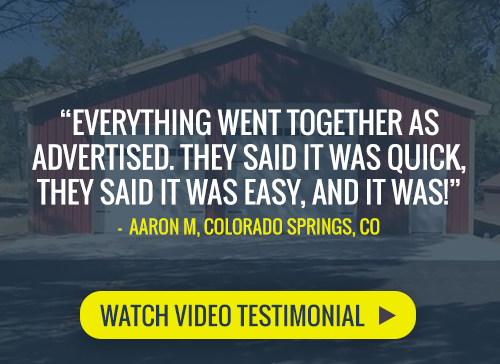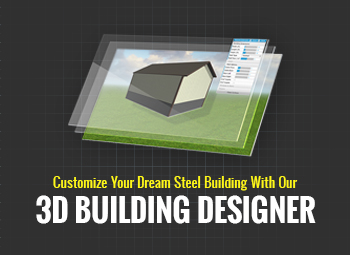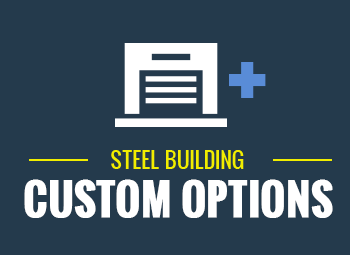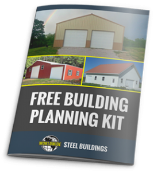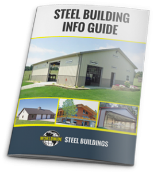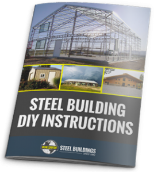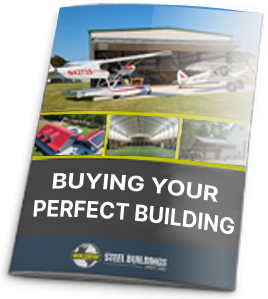Glossary of Steel Construction Terms
Basic Terms and Descriptions Applicable to Steel Buildings:
Accessory: A building product which supplements a basic solid panel building such as a door, window, light transmitting panel, roof vent, cupola, soffit, wainscot, overhang, etc.
Agricultural Building: A structure designed and constructed to house farm implements, hay, grain, poultry, livestock, or other agricultural products. Such structures should not include: spaces meant for habitation or to be occupied, spaces in which agricultural products are processed, treated, or the possibility of being as a place of occupancy by the general public.
Anchor Bolts: Bolts used to anchor members to a foundation or other support.
Anchor Bolt Plan: A plan view drawing showing the diameter, location, and projection of all anchor bolts for the components of the metal building system and may show column reactions (magnitude and direction). The maximum base plate dimensions may also be shown.
Approval Drawings: A set of drawings that may include framing plans, elevations, and sections through the building for approval of the dealer.
ASD: Allowable Stress Design.
Assembly: A group of mutually dependent and compatible components or subassemblies of components.
Astragal: A closure between the two leaves of a double swing or double slide door.
Bar Joist: A name commonly used for open web steel joist.
Base Angle: An angle secured to a wall or foundation used to attach the bottom of the wall paneling.
Base Plate: A plate attached to the bottom of the column, which rests on a foundation or other support, usually secured by anchor bolts.
Bay: The space between the main frames measured normal to the frame.
Beam and Column: A structural system consisting of a series of rafter beams supported by columns. Often used as the end frame of an I-beam building.
Bearing End Frame: See “Beam and Column”
Bearing Plate: A steel plate that is set on top of a masonry support on which a beam or purlin can rest.
Bill of Materials: A list that enumerates by part number or description each piece of material or assembly to be shipped. Also called tally sheet or shipping list.
Bird Screen: Wire mesh used to prevent birds from entering the building through ventilators and louvers.
Blind Rivet: A small headed pin with expandable shank for joining light gauge metal. Typically it is used to attach flashing, gutters, etc.
Bracing: Rods, angles, or cables used in the plane of the roof and walls to transfer loads, such as wind, seismic, and crane thrusts to the foundation.
Bracket: A structural support projecting from a structural member. Examples are canopy brackets, lean-to brackets, and crane runway brackets.
British Thermal Unit (BTU): The amount of heat required to raise the temperature of one pound of water by one degree of Fahrenheit.
Building: A structure forming an open, partially enclosed, or enclosed space constructed by a planned process of combining materials, components, and subsystems to meet specific conditions of use.
Building Aisle: A space defined by the length of the building and the space between building columns.
Building Code: Regulations established by a recognized agency describing design loads, procedures, and construction details for structures usually applying to a designated political jurisdiction (city, county, state, etc.).
Butt Plate: The end plate of a structural member usually used to rest against a like plate or another member in forming a connection. Sometimes called a splice plate or bolted end plate.
Bypass Girt: A wall framing system where the girts are mounted on the outside of the columns.
“C” Section: A member in the shape of a block “C” formed from steel sheet, which may be used either singularly or back to back.
Canopy: A projecting roof system that is supported and restrained at one end only.
Chalking: When the paint finish on panels has a white powder film due to over exposure.
Cladding: The exterior metal roof and wall paneling of a Metal Building System. See also “Covering”.
Clip: A plate or angle used to fasten two or more members together.
Closure Strip: A strip, formed to the contour of ribbed panels and used to close openings created by ribbed panels joining other components, either made of resilient material or metal.
Collateral Loads: The weight of additional permanent materials required by the contract, other than the Building System, such as sprinklers, mechanical and electrical systems, partitions and ceilings.
Column: A main member used in a vertical position on a building to transfer loads from main roof beams, trusses, or rafters to the foundations.
Component: A part used in a Metal Building System. See also “Components and Cladding”.
Components and Cladding: Members which include girts, joist, purlins, studs, wall and roof panels, fasteners, end wall columns and end wall rafters of bearing end frames, roof overhang beams, canopy beams, and masonry walls that do not act as shear walls.
Concealed Clip: A hold down clip used with a wall or roof panel system to connect the panel to the supporting structure without exposing the fasteners on the exterior surface.
Connection: The means of attachment of one structural member to another.
Covering: The exterior metal roof and wall paneling of a Metal Building System.
Cross Section: In construction, a cross section is a depiction of the building structure from the side, that shows what the building would look like if it were cut in half on a vertical plane. This view shows internal components that would not otherwise be visible because of the building’s walls and framing.
Curtain Wall: A curtain wall is a non-structural, non-load-bearing wall. Its primary purpose is to keep occupants, sounds and temperature inside of a building or room and the elements out.
Dead Loads: The dead load of a building is the weight of all permanent construction, such as floor, roofing, framing, and covering members.
Dealer: A party who, as a routine part of his/her business, buys Metal Building Systems from a manufacturer for the purpose of resale.
Deflection: In engineering, deflection is the movement of a beam from its original position.
Deformation: Deformation is the term for bending, twisting or otherwise warping of structural components of a building. Deformation can be caused by applied load and stress on the building.
Design Professional: Any architect or engineer.
Diagonal Bracing: See “Bracing”.
Door Guide: An angle or channel used to stabilize or keep plumb a sliding or rolling door during its operation.
Downspout: A conduit used to carry water from the gutter of the building.
Drift (Snow): The snow accumulation at a height discontinuity.
Drift Pin: A tapered pin used during erection to align holes in steel members to be connected by bolting.
Eave: The line along the sidewall formed by the intersection of the planes of the roof and the wall.
Eave Canopy: A projecting roof system on the sidewall whose overhanging edge is supported at the building.
Eave Height: The vertical dimension from the finished floor to the top of the eave strut.
Eave Strut: A structural member located at the eave of a building that supports roof and wall paneling.
End Bay: The bays adjacent to the end walls of a building. Usually the distance from the end wall to the first interior mainframe measured normal to the end wall.
End Frame: A frame located at the end wall of a building that supports the loads from a portion of the end bay.
End Post: See “End wall Column”.
End Wall: An exterior wall that is parallel to the main frames of the building.
End Wall Column: A vertical member located at the end wall of a building that supports the girts. In post and beam end wall frames the end wall columns also support the rafter.
End Wall Overhang: See “Purlin Extension”.
Engineer/Architect of Record: The engineer or architect who is responsible for the overall design of the building project. The manufacturer’s engineer is not the Engineer of Record.
Installation: The on-site assembling of fabricated Metal Building System components to form a completed structure.
Erection Bracing: Materials used by erectors to stabilize the building system during erection, also typically referred to as temporary bracing.
Erection Drawings: Roof and wall erection (framing) drawings that identify individual components and accessories furnished by the manufacturer in sufficient detail to permit proper Erection of the Metal Building System.
Erector: A party who assembles or erects a Metal Building System.
Expansion Joint: A break or space in construction to allow for thermal expansion and contraction of the materials used in the structure.
Exterior Framed: A wall framing system where the girts are mounted on the outside of the columns.
Fabrication: The manufacturing process performed in a plant to convert raw material into finished Metal Building System components. The main operations are cold forming, cutting, punching, welding, cleaning, and painting.
Facade: An architectural treatment, partially covering a wall, usually concealing the eave and/or rake of the building.
Fading: Refers to the paint finish on panels becoming less vibrant of color.
Fascia: A decorative trim or panel projecting from the face of a wall.
Field: The job site, building site, or general marketing area.
Filler Strip: See “Closure Strip”.
Fixed Clip: A standing seam roof system hold down clip that does not allow the roof panel to move independently of the roof substructure.
Fixed Base: A column base that is designed to resist rotation as well as horizontal or vertical movement.
Flange: The projecting edge of a structural member (e.g. the top and bottom horizontal projections of an I beam).
Flange Brace: A member used to provide lateral support to the flange of a structural member.
Flashing: The metal used to “trim” or cover the juncture of two planes of material.
Floating Clip: A standing seam roof system hold down clip that allows the roof panel to horizontally move independently of the roof substructure. Also known as a “Sliding Clip: or “Slip Clip”.
Flush Girts: A wall framing system where the outside flange of the girts and columns are flush.
Footing: A pad or mat, usually concrete, located under a column, wall, or other structural member, that is used to distribute the loads from that member into the supporting soil.
Foundation: The substructure, which supports a building or other structure.
Framed Opening: Framing members and flashing which surround an opening.
Framing Plans: See “Erection Drawings”.
Gable: The triangular portion of the end wall from the level of the eave to the ridge of the roof.
Gable Overhang: See “Purlin Extension”.
Gable Roof: A roof consisting of two sloping roof planes that form a gable at each end.
Galvanized: Steel coated with zinc for corrosion resistance.
Girder: A main horizontal or near horizontal structural member that supports vertical loads. It may consist of several pieces.
Girt: A horizontal structural member that is attached to sidewall or end wall columns to support paneling.
Grade: The term used when referring to the ground elevation around a building.
Grade Beam: A concrete beam around the perimeter of a building.
Ground Snow Load: The probable weight of snow on the ground for a specified recurrence interval exclusive of drifts or sliding snow.
Grout: A mixture of cement, sand, and water used to fill cracks and cavities. Sometimes used under base plates or leveling plates to obtain uniform bearing surfaces.
Gutter: A light gauge metal member at an eave, valley or parapet designed to carry water from the roof to downspouts or drains.
Hair Pin: “V” shaped reinforcing steel used to transfer anchor bolt shear to the concrete floor mass.
Haunch: The deepened portion of a column or rafter designed to accommodate the higher bending moments at such points. (Usually occurs at the intersection of the column and rafter.)
Header: The horizontal framing member located at the top of a framed opening.
High Strength Bolts: Any bolt made from steel having a tensile strength in excess of 100,000 pounds per square inch.
High Strength Steel: Structural steel having a yield stress in excess of 36,000 pounds per square inch.
Hip: The line formed at the intersection of two adjacent sloping planes of a roof.
Hip Roof: A roof that is formed by sloping planes from all four sides.
“I” Beam: See “S” Shape.
Impact Wrench: A power tool used to tighten nuts or bolts.
Insulation: Any material used in building construction to reduce heat transfer.
Jamb: The vertical framing members located at the sides of an opening.
Jig: A device used to hold pieces of material in a certain position during fabrication.
Joist: A light beam for supporting a floor or roof.
Kick-Out (Elbow) (Turn-Out): An extension attached to the bottom of a downspout to direct water away from a wall.
Knee: The connecting area of a column and rafter of a structural frame such as a rigid frame.
Knee Brace: A diagonal member at a column and rafter intersection designed to resist horizontal loads.
Lean-To: A structure having only one slope and depending upon another structure for partial support.
Length: The dimension of the building measured perpendicular to the main framing from outside to outside of end wall girts.
Light Transmitting Panel: Panel used to admit light.
Liner Panel: A metal panel attached to the inside flange of the girts or inside of a wall panel.
Live Load: Loads that are produced (1) during maintenance by worker, equipment, and materials, and (2) during the life of the structure by movable objects and do not include wind, snow, seismic, or dead loads. Also see “Roof or Floor Live Loads”.
Louver: An opening provided with fixed or movable slanted fins to allow flow of air.
Main Frame: An assemblage of rafters and columns that support the secondary framing members and transfer loads directly to the foundation.
Manufacturer: A party who designs and fabricates a Metal Building System.
Manufacturers Engineer: An engineered employed by a manufacturer who is in responsible charge of the structural design
Mastic: See “Sealant”
Metal Building System: A complete integrated set of mutually dependent components and assemblies that form a building including primary and secondary framing, covering and accessories, and are manufactured to permit inspection on site prior to assembly or erection
Mezzanine: An intermediate level between floor and ceiling occupying a partial area of the floor space.
Moment: The tendency of a force to cause rotation about a point or axis.
Moment Connection: A connection designed to transfer moment as well as axial and shear forces between connecting members.
Monolithic Construction: A method of placing concrete grade beam and floor slab together to form the building foundation without forming and placing each separately.
Multi-Gable Building: Buildings consisting of more than one gable across the width of the building.
Multi-Span Building: Buildings consisting of more than one span across the width of the building. Multiple gable buildings and single gable buildings with interior columns are examples.
Oil Canning: A waviness that may occur in flat areas of light gauge formed metal products. Structural integrity is not normally affected by this inherent characteristic; therefore oil canning is an aesthetic issue. Oil canning is not a cause for rejection of the material.
Open Web Steel Joist: Lightweight truss.
Order Documents: The documents usually required by the manufacturer in ordinary course of entering and processing an order.
Overhead Door: See “Sectional Overhead Doors”.
Panels: See “Cladding”.
Panel Notch: A notch or block out formed along the outside edge of the floor slab to provide support for the wall panels and serve as a closure along their bottom edge.
Parapet: That portion of the vertical wall of a building that extends above the roofline.
Peak: The uppermost point of a gable.
Peak Sign: A sign attached to the peak of the building at the end wall showing the building manufacturer.
Personnel Doors: Doors used by personnel for access and exit from a building.
Pick Point: The belted part of panel bundles where the bundle is to be lifted.
Piece Mark: A number given to each separate part of the building for erection identification. Also called mark number and part number.
Pier: A concrete structure designed to transfer vertical load from the base of a column to the footing.
Pitch: See “Roof Slope”.
Portal Frame: A rigid frame so designed that it offers rigidity and stability in its plane. It is generally used to resist longitudinal loads where other bracing methods are not permitted.
Post: See “Column”.
Post and Beam: A structural system consisting of a series of rafters beams supported by columns. Often used as the end frame of a building.
Primary Framing: See “Main Frame”.
Public Assembly: A building or space where 300 or more persons may congregate in one area.
Purlin: A horizontal structural member that supports roof covering and carries loads to the primary framing members.
Purlin Extension: The projection of a roof beyond the plane of an end wall.
Rafter: The main beam supporting the roof system.
Rake: The intersection of the plane of the roof and the plane of the end wall.
Rake Angle: Angle fastened to purlins at rake for attachment of end wall panels.
Rake Trim: A flashing designed to close the opening between the roof and end wall panels.
Retrofit: The placing of new metal roof or wall systems over deteriorated roofs and walls.
Rib: The longitudinal raised profile of a panel that provides much of the panel’s bending strength.
Ribbed Panel: A panel, which has ribs with sloping sides and forms a trapezoidal shaped void at the side lap.
Ridge: The horizontal line formed by opposing sloping sides of a roof running parallel with the building length.
Ridge Cap: A transition of the roofing materials along the ridge of a roof; sometimes called ridge roll or ridge flashing.
Rigid Connection: See “Moment Connection”.
Rigid Frame: A structural frame consisting of member joined together with moment connections so as to render the steel frame stable with respect to design loads, without the need for bracing in its plane.
Roll-Up Door: A door that opens by travelling vertically and is gathered into a roll suspended some distance above the floor.
Roof Covering: The exposed exterior roof surface consisting of metal panels.
Roof Live Load: Loads that are produced (1) during maintenance by workers, equipment, and materials and (2) during the life of the structure by movable objects which do not include wind, snow, seismic or dead loads.
Roof Overhang: A roof extension beyond the end wall or sidewall of a building.
Roof Slope: The tangent of the angle that a roof surface makes with the horizontal, usually expressed in units of vertical rise to 12 units of horizontal run.
Roof Snow Load: The load induced by the weight of snow on the roof of the structure.
“S” Shape: A hot rolled beam with narrow tapered flanges.
Sandwich Panel: A panel used as covering consisting of an insulating core material with inner and outer metal skins.
Screw Down Roof System: A screw down roof system is one in which the roof panels are attached directly to the roof substructure with fasteners that penetrate through the roof sheets and into the substructure.
Sealant: Any material that is used to seal cracks, joints, or laps.
Secondary Framing: Members that carry loads from the building surface to the main framing. For example purlins and girts.
Seaming Machine: A mechanical device that is used to close and seal the side seams of standing seam roof panels.
Sectional Overhead Doors: Doors constructed in horizontally hinged sections. They are equipped with springs, tracks, counter balancers, and other hardware, which roll the sections into an overhead position clear of the opening.
Seismic Load: The lateral loading acting in any direction on a structural system due to the action of an earthquake.
Self-Drilling Screw: A fastener that combines the function of drilling and tapping.
Self-Tapping Screw: A fastener that taps its own threads in a predrilled hole.
Seller: A party who sells a Metal Building System with or without its erection or other fieldwork.
Shipping List: See “Bill of Materials”.
Shop Primer Paint: The initial coat of primer paint applied in the shop. A temporary coating designed to protect the steel during shipping and erection until the building exterior and interior coverings have been installed. This coating may or may not serve as a proper prime coat for other finishing paints.
Side Lap Fastener: A fastener used to connect panels together above their length.
Sidewall: An exterior wall, which is perpendicular to the frames of a building system.
Sidewall Overhang: See “Eave Canopy”.
Sill: The bottom horizontal framing member of a wall opening such as a window or louver.
Simple Span: A term used in structural design to design a beam support condition at two points which offers no resistance to rotation at the supports.
Single Slope: a sloping roof in one plane. The slope is from one sidewall to the opposite sidewall.
Slide Door: A single or double leaf door, which opens horizontally by means of sliding on an overhead trolley.
Sliding clip: A standing seam roof system hold down clip, which allows the roof panel to thermally expand independently of the roof substructure.
Slope: See “Roof Slope”.
Snow Drift: See “Drift (Snow)”.
Snow Load: See “Roof Snow Load”.
Soffit: A material, which covers the underside of an overhang.
Span: The distance between two supports.
Specification (Metal Building System): A statement of a set of Metal Building System requirements describing the loading conditions, design practices, materials and finishes.
Splice: A connection in a structural member.
Spreader Bar: Elongated bar with attached hooks and/or chains used from a crane to lift long sections of panels, or structural members such as rafters.
Spud Wrench: A tool used by erectors to line up holes and to make up bolted connections; a wrench with a tapered handle.
Square: The term used for an area of 100 feet.
Standing Seam: Side joints of roof panels that are arranged in a vertical position above the roofline.
Standing Seam Roof System: A roof system in which the side laps between the roof panels are arranged in a vertical position above the roofline. The roof panel system is secured to the roof substructure by means of concealed hold down clips attached with screws to the substructure, except that through fasteners may be used at limited locations such as at ends of panels and at roof penetrations.
Stiffener: A member used to strengthen a plate against lateral or local buckling.
Stiffener Lip: A short extension of material at an angle to the flange of cold formed structural members, which adds strength to the member.
Stitch Screw: A fasteners connecting panels together at the side lap.
Stud: A vertical wall member to which exterior or interior covering or collateral material may be attached. May be either load bearing or non-load bearing.
Tapered Members: A built up plate member consisting of flanges welded to a variable depth web.
Tensile Strength: The longitudinal pulling stress a material can bear without tearing apart.
Thermal Block: A spacer of low thermal conductance material that is installed between the purlin and roof insulation, to prevent energy loss.
Thermal Conductance, (C-Factor): The time rate of heat flow through unit areas of a body induced by unit temperature difference between the body surfaces. Units are BTU / (Hour x ft 2 x degree F) [Imperial system] or Units / (m 2 x degree C) [ SI system]. See “Thermal Resistance”.
Thermal Conductivity (K-Factor): The time rate of heat flow through unit thickness of a flat slab of a homogenous material in the perpendicular direction to the slab surfaces induced by unit temperature gradient. Units for K are (BTU x in) / (hour x ft 2 x degree F) or BTU/ (hour x ft x degree F) [Imperial system] and watts / (m x degree C) [SI system]. See “Thermal Resistivity”.
Thermal Resistance (R-Value): Under steady conditions, the mean temperature difference between two defined surfaces of material or construction that induces unit heat flow through unit area. Note: Thermal resistance and thermal conductance are reciprocals. To obtain the U-Factor, overall thermal transmittance. R-Value for materials and/or combinations of materials must first be evaluated. U-Factor is then the reciprocal of the sum of these individual R-Values.
Thermal Resistivity: Under steady conditions, the temperature difference between parallel surfaces of a slab (large enough so there is no lateral heat flow) of unit thickness that induces unit heat flow through unit area. Note: Thermal resistivity and thermal conductivity are reciprocals. Thermal resistivity is the R-Value of a material of unit thickness.
Thermal Transmittance (U-Factor): The time rate of heat flow per unit is under steady conditions from the fluid on the warm side of a barrier to the fluid on the cold side, per unit temperature difference between the two fluids. To obtain, first evaluate the R-Value and then compute its reciprocal.
Through-Fastened Roof System: A roof system in which the roof panels are attached directly to the roof substructure with fasteners, that penetrates through the roof sheets and into the substructure.
Ton: 2,000 pounds.
Translucent Panels: See “Light Transmitting Panels”.
Transverse: The direction parallel to the main frames.
Trim: The light gauge metal used in the finish of a building, especially around openings and at intersections of surfaces. Sometimes referred to as flashing.
Truss: A truss is a structure made up of three or more structural members, with each member designed to carry a tension or compression force. The entire structure then acts as a beam.
Uplift: Wind load on a building, which causes a load in the upward direction.
Valley Gutter: A heavy gauge material used for multi-gabled buildings or between buildings.
Vapor Barrier: Material used to retard the flow of vapor or moisture to prevent condensation from forming on a surface.
Wainscot: Wall material, used in the lower portion of the wall that is different from the material in the rest of the wall.
Walk Door: See “Personnel Door”.
Wall Covering: The exterior wall surface consisting of panels.
Web: That portion of a structural member between the flanges.
Web Stiffener: See “Stiffener”.
Width: The dimension of the building measured parallel to the main framing from outside to outside of sidewall girts.
Wind Bent: See “Portal Frame”.
Wind Column: A vertical member designed to withstand horizontal wind loads, usually in the end wall.
X-Bracing: Bracing system with members arranged diagonally in both directions to form an “X”. See “Bracing”.
“Z” Section: A member cold formed from steel sheet in the approximate shape of a “Z”.
Zinc-Aluminum Coated: Steel coated with an alloy of zinc and aluminum to provide corrosion resistance.
